
Virtually all of these Chinese soldiers, circa 1937, have a C96-type pistol tucked into their waistbands, many with numerous pouches for stripper clips.
Frankly, very few, if anyone, would describe the Chinese Warlord period—from the death of Yuan Shikai in 1916 to Chiang Kai-Shek’s exile to Taiwan in 1949—as “the best of times.” It was a period of unspeakable violence, ruthlessness and unparalleled intrigue. Alliances were forged and broken at the drop of a hat as provincial strong men, the “warlords,” assembled vast armies in their quest to control one of the world’s largest countries. Everyone needed guns, lots of them—and right away!
Curiously, most Americans have little knowledge of this period. We tend to think about ancient China as a genteel monarchy intent upon ceremonial traditions or, in more modern times, as an aggressive, Communistic powerhouse, relentless in its goal for global dominance. So how did things change? What was the Warlord Period and what did it have to do with small arms?
For hundreds of years, China was ruled by the Qing Dynasty that was supported by a traditional military in which strength was reflected by the number of combatants. Given China’s size and vast army, any challenge would have been foolhardy. So went conventional wisdom.
But the Japanese thought differently, handing China a humiliating defeat during the first Sino-Japanese war of 1894-1895. Afterwards, everything changed; China was saddled with unfair trade agreements, and the once-powerful Qing Dynasty was seen as outmoded and incompetent. Angry and disenchanted, the populace clamored for a revolution.
Following several small-scale rebellions and a more extensive uprising by the military, Gen. Yuan Shikai was recalled from retirement to work out a settlement that included an abdication of the reigning dynastic members. He ruled China for several years, from 1912-1916, eventually dying without having groomed a successor. As his subordinates struggled for control by building personal armies, China was plunged into turmoil, the depth of which we, as Westerners, can hardly comprehend. In the United States, we often still lament our four years of civil war—the Chinese Civil War lasted for more than 30 years.
It was during that period that the warlord came into being, defined as a man who “exercises effective government control over a fairly well-defined region by means of a military organization that obeys no higher authority than himself” (Sheridan, Chinese Warlord, p. 1). There weren’t just one or two warlords, there were many, and the sizes of some of their armies were extraordinary. According to Thomas B. Nelson, between 1928-1929, three of these warlords fielded armies of nearly 230,000 men. Depending on the circumstances, they would form a temporary alliance, then change their minds and fight each other the following week. For the most part, their focus was on Beijing, for control of that city meant international recognition, supreme power and the potential for inordinate wealth.
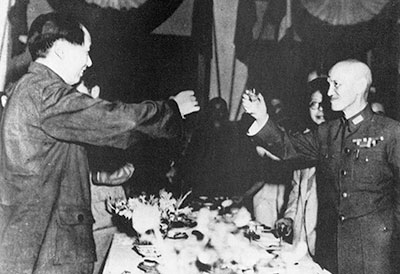
But it was not just the warlords. The civil war also involved the armies of the Chinese Nationalist Party, known as the Kuomintang (KMT), led by Sun Yat-sen (later Chiang Kai-Shek), and the Communist Party of China (CPC) led by Mao Tse-Tung. As with the warlords, they too shifted alliances as was convenient. Initially, the KMT and CPC fought together against the warlords, then against each other, uniting again to fight the invading Japanese from 1937-1945, then against each other again. In June 1948, troop strengths were cited as 3.6 million for the nationalists and 2.8 million for the Chinese communists. It was one battle after another until a truce was finally signed in 1949.
As one might infer, from 1916-1949, the need for arms was unprecedented, as nearly every able-bodied man in China was issued some kind of small arm. The problem was where to find them, as indigenous production was almost non-existent. So the warlords looked to the West.
Ironically, while the Chinese had first invented gunpowder, it was Europeans who incorporated its use into the arms industry. At first, their arms were relatively crude, with dirty, blackpowder residue gumming up every attempt to create a reliable, self-loading mechanism. But after Paul Vieille’s invention of smokeless powder in 1884, the race was on, as new arms were developed and patented at a dizzying rate. By the early 20th century, Deutsche Waffen und Munitionfabriken (DWM) was manufacturing Lugers, Fabrique Nationale was making its Model 1900s and Model 1903s, and Colt was in production with the M1911.
When the Warlord Era began, the Western powers were busy making guns for their own countries, as World War I was in full swing. But, by the 1920s, World War I was over and virtually every country was suffering through a recession. For the arms manufacturers, the situation was particularly bleak, as the world was awash in surplus firearms. Desperately short of funds, the emergent need from China was a godsend.
Of course, there were a few “issues.” In an effort to limit the carnage, a number of Western powers signed the Arms Embargo Agreement of May 5, 1919, specifically designed to limit the warlords’ access to war materiel. Signatories included Britain, Russia, France, Japan, Spain and the United States, with tacit support from Belgium and Italy. However, as FN, Mauser, Astra and Star quickly determined, handguns were not considered to be implements of war, and were not bound by the agreement. The arms manufacturers were delighted; handgun production was re-started and streamlined, new trade agreements were implemented and business resumed at full force.
The warlords (or their emissaries) came to buy, haggling was minimal and profits were enormous. For example, FN pistols that sold in France for 50-80 francs could be sold in China for 360-500 francs. A manufacturer’s dream, arms were ultimately shipped from virtually every country that had signed or expressed support for the arms embargo.
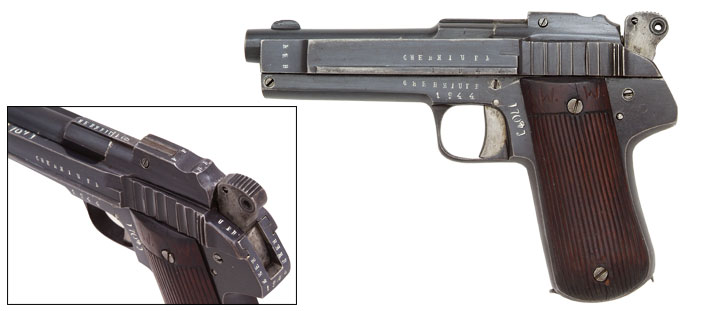
In the end, it didn’t really matter whether the gun was new or used. As long as it would fire, and ammunition was available, there was a buyer. That was an incredible gift for almost everyone involved in the arms trade and a real dumping ground for surplus World War I armaments, much of which was sold and exported with little regard for condition or suitability.
Yet, for the warlords, the cost was ruinous. Posturing aside, most of their revenue came from land taxes, domestic loans and outright exploitation. In Arming The Chinese, Anthony Chan mentioned that in Shangdong, “Zhang Zongchang’s military expenditures were over 85% of his budget from 1925-1928,” an expense that was typical of many provinces. As the warlords ran out of money, it became clear that something else needed to be done; an obvious solution was to make the guns domestically.
The problem was that China had yet to enter its own industrial revolution. There wasn’t an accomplished firearms industry and there were no firearms specialists, at least not to the level of the Europeans. So, incentives were given, specialists hired and manufacturing equipment purchased. Familiar with many Western firearms and having absolutely no regard for patent protections, it is not surprising that quite a few firearms were directly copied, especially from Mauser and FN, who enjoyed enviable reputations for their well-made and reliable products.
The warlords were particularly impressed with semi-automatic pistols, and directed their manufacturers to make “more of the same,” especially with respect to the FN Model 1900 in 7.65 mm (.32 ACP) and the charismatic Mauser C96 in 7.63 mm Mauser (explaining why those are the most frequently encountered copies). Considerable latitude was apparently given with respect to details, as examination shows a near-infinite variety of differences, and not just the markings.
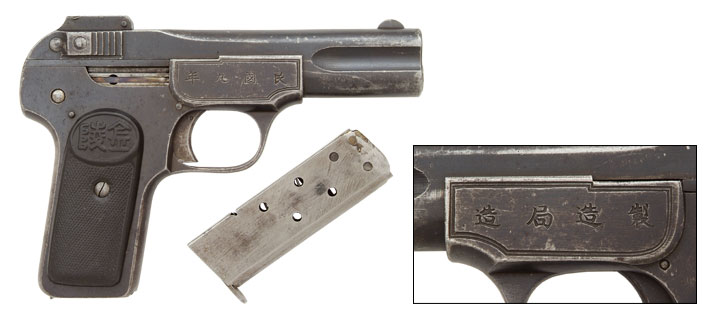
The FN Model 1900 was particularly popular. The Shanghai Arsenal made a standard-size copy in addition to a carbine version that was considerably larger, fitted with a tangent sight and slotted for a shoulder stock. The Jinling (later Nanjing) Arsenal Model 1900s were amongst the few that were manufacturer marked and dated. Other manufacturers re-designed the pistol more extensively to fire the more potent 7.63 mm cartridge, enlarging the pistol, sometimes slotting the backstrap and fitting the frame with a second safety or selector switch.
As their completion involved a lot of hand-marking and hand-fitting, few, if any, were identical. Case in point: About 100 standard-size FN 1900s were examined before writing this article. Several were marked with the same serial number “26063,” as if the assembler mistook the serial number for a standard identifier, occasionally prefixed or suffixed with a different digit. Several had a second safety lever that blocked the trigger. Some had a flat backstrap, others a curved backstrap. Safeties had round, ovular or irregularly contoured thumbpads that were checkered, grooved or scalloped. No two had the same machine markings or the same set of stampings—every single one was different. And so it went with the vast majority of arsenal-made handguns.
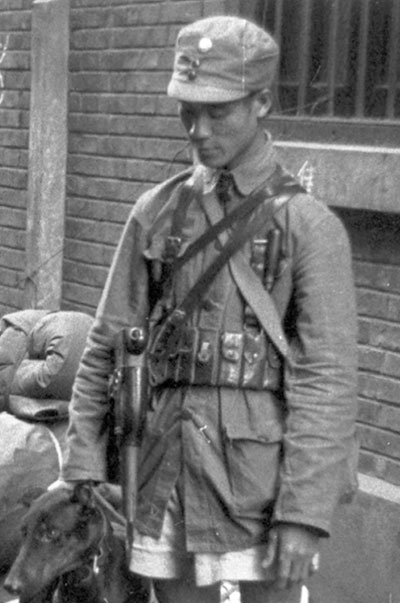
For those who wanted and could afford the best, eyes turned to the Mauser C96, whose ownership was a real status symbol. A powerful handgun in its own right, it could be carried in its hollowed shoulder stock or be attached to the stock for use as a short-barreled carbine. Ubiquitous in China, Mauser exported between 300,000-400,000 of these pistols from 1916 to 1936. While most were Standard Wartime Commercials, virtually all variations made their way east, including Conehammers, Flatsides, Early and Late Postwar Bolos, and 1930 Commercials. In 1931, after Mauser unveiled its Model 712 (Schnellfeuer), there were even more choices. And that says nothing of the Spanish counterparts offered by Astra and Beistegui Hermanos.
Virtually all were copied in varying degree by major and minor Chinese arsenals, including a handful of carbines made by the Taku Naval Dockyard and TsingTao Iron Works. Most were based on the Mauser, for the German firm had been the first to make inroads into China, and had certainly sold the largest number of pistols. The larger arsenals—Hanyang, Taku Naval Dockyard and Taiyaun (Shanxi)—had significant serialed production, and marked their C96s with appropriate identifiers. All were chambered for the 7.63 mm Mauser except for a small run of Taiyuan (Shanxi) copies in .45 ACP.
The C96s made by the smaller arsenals came in several sizes and with a variety of markings. Mausers were copied complete with their logo, but this was rarely reproduced correctly. Several examples have been reported with “Wauser” or “Fauser” banners. The same applied to the Spanish C96s, whereby the Chinese introduced their own versions of the Astra and Beistegui machine pistols, moving from 10-shot, to 20-shot, to those with a detachable magazine, almost as quickly as the originals reached the mainland.
Apart from the FN Model 1900 and C96 copies, there were a host of indigenous pistols that provide a fascinating study, for they have been largely neglected in Western literature. The biggest issue for collectors/historians to overcome is their inability to be categorized by conventional standards. In many cases, we cannot even answer the most basic questions: Who made them, where were they made, for whom and in what quantity?
In general, handgun production was a sidebar for most of the factories, referenced as “arsenals,” whose primary concern was to make rifles or machine guns. Production was relatively small and only tangentially mentioned in the few remaining records. Further, many arsenals made a deliberate effort to obscure the origin of the guns, neglecting to mark them with an identifier or, even worse, slathering the guns with a host of faked markings, almost always with Western letters and proofs, frequently with reference to FN or Mauser.
While Westerners might find the markings laughable, their application made a lot of sense to the Chinese. The arsenals were well aware that their technology lagged behind their European counterparts, which begged the question: Why would anyone want a Chinese-arsenal-made gun over a real FN or Mauser? Well, they wouldn’t—but what if the Chinese guns were marked as FNs or Mausers? Who would know? Most Chinese had no concept of the English language, just as most Westerners could not read Chinese script. So why not counterfeit the FN and Mauser logos and place both on the same gun, giving it a “double stamp of authenticity?”
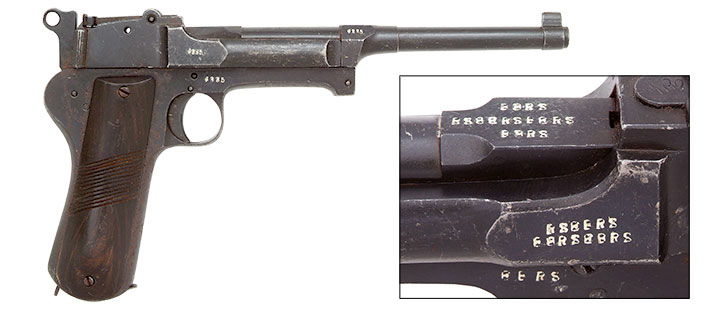
Another interesting observation is just how many different designs were copied. Other than FN Model 1900s and C96s, Chinese-made Mauser Model 1914-type pistols scaled up for 7.63 mm, pistols based on the Spanish Eibar-form with a mid-frame safety, copies of the Star A Carbine, the Colt Model 1900 Sight Safety, and crazy, fantasy-like guns reflecting a mixture of Astra, Luger, Mannlicher, Mauser and Star components have all been observed. Some were optimistically fitted with a bayonet lug, others were slotted for a hollow, Mauser-type shoulder stock. There were distinctive Asiatic-form pistols with rounded butts, loose copies of the Hungarian Frommer Model 1906, Colt Model 1903, Colt M1911, the Austrian Little Tom and even the FN High Power, virtually all marked with misspelled names or nonsensical lettering.
Yet, despite their outward similarity to the original products, most of the copies were simplified. The vast majority were single-action blowbacks, usually with an internal hammer. The concept of a sight picture was apparently extraneous, as quite a few pistols were made without a rear sight, encouraging the new owners to enjoy an early Kodak moment: just “point-and-shoot.” Pinned-in barrels were commonplace and a lot easier to manufacture than the easily removable Eibar-type barrels with their serrated, interrupted lugs. That disassembly required punches or a screwdriver was irrelevant, as was the concept of fieldstripping. Cleaning aside, why should conscripted soldiers have to disassemble their guns? Even if a part needed to be replaced, there was so much hand-fitting that any replacements would have needed an armorer to install.
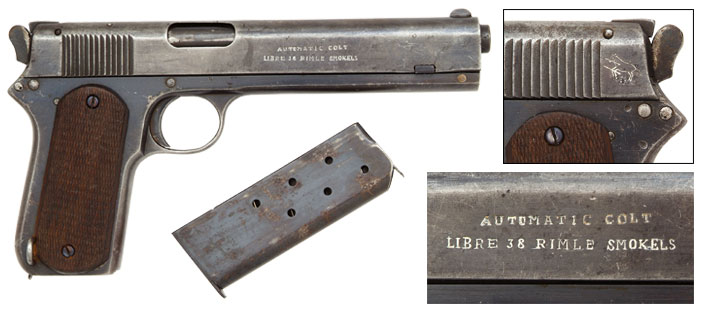
And then there were the Chinese-made revolvers. Most were fairly close copies of the Colt or S&W, usually in .32 S&W or .38 Spl., but a few were based on the top-break, Japanese T26. Most had a narrow grip to better fit smaller hands, and counterfeit markings, usually based on Colt or S&W logos.
But all good things come to an end, and, concerning the emergence of “wild-looking” handguns, the end started to close in about 1930, when the last of the warlords banded together to fight Chiang Kai-Shek during the Central Plains War, a conflict that involved more than 1.4 million troops and 300,000 casualties.
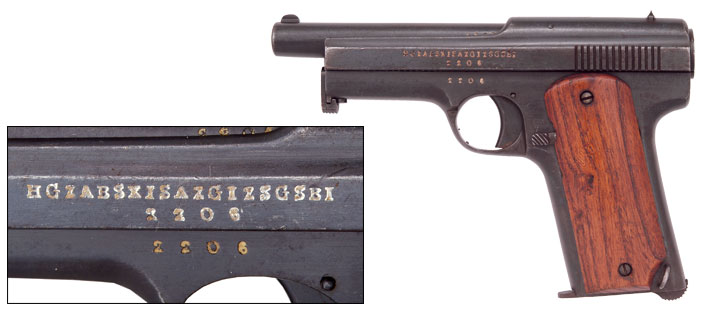
After that, even though the warlord guns remained in service until 1949, most of the new armament issued to the KMT and CPC (by then renamed the People’s Republic of China) was made to military-prescribed standards. Once the communists took control, trade with most outside nations was curtailed, firearms production became even more regulated, and most of the older guns were destroyed or mothballed in storage facilities.
In the early 1980s, under the Carter administration, trade was re-opened to include the sale of firearms. Many of the remaining warlord pistols, particularly C96s, were shipped to the United States where thousands arrived via Navy Arms, Four Happiness, Oyster Bay Imports, Keng Imports and others. Depending on their condition, some were sold “as-is,” while others needed considerable re-working. Guns were fitted with re-lined barrels and re-chambered to 9 mm Luger, and Model 712 parts were assembled to newly made frames with a detachable magazine and re-sold as the “Warlord Model TU-711.” Another U.S. creation was the “Black Forest Carbine” wherein a standard C96 was used as the basis to make a Mauser C96 carbine look-alike. These marketing efforts, ludicrous for serious collectors, provided a host of lower-cost, pseudo-collectibles for the uninitiated—but that is a different story.
Given the warlord handguns’ heavy use, their high rate of attrition and the relatively small numbers still extant, the task of quantifying them is difficult. Language barriers, the lack of original documentation and the intent of many manufacturers to counterfeit their origin makes the task nearly impossible. But that is what makes collecting and historical research so interesting. And, with today’s technology and global resources, much of what was once impossible is now possible—it just takes a little longer!